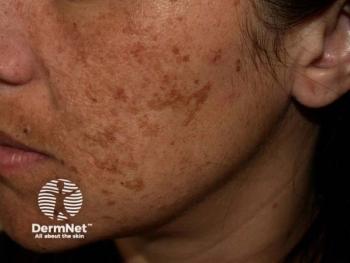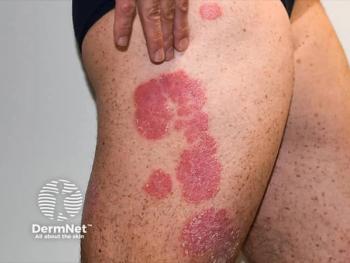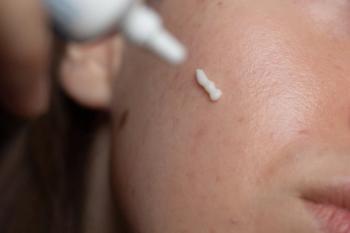
Severe Alopecia Areata Linked to Higher Atopic Dermatitis Risk
Key Takeaways
- Alopecia areata involves immune dysregulation and is linked to conditions like atopic dermatitis, with severity affecting comorbidity risk.
- A study found increased AD prevalence and incidence in patients with more severe AA, particularly in adolescents.
A recent study reveals a significant link between alopecia areata severity and increased risk of atopic dermatitis, especially in adolescents.
Affecting approximately 0.21% of the US population, alopecia areata (AA) often emerges in childhood and may range from mild patchy hair loss to more severe phenotypes such as alopecia totalis or universalis. While the precise cause of AA remains unclear, it is known to involve immune dysregulation—primarily through cytotoxic CD8+ NKG2D+ T-cells—and the collapse of immune privilege in hair follicles. These events trigger inflammation, with cytokines like interferon-γ and IL-15 fueling a T-helper 1 (Th1) driven response via the Janus kinase-signal transducer and activator of transcription (JAK-STAT) pathway.1
AA has also been linked to other immune-mediated and inflammatory conditions, including atopic dermatitis (AD), psoriasis, rheumatoid arthritis, and inflammatory bowel disease. AD, in particular, has a long-standing association with AA.2 While past studies have compared patients with AA to healthy controls, the relationship between AA severity and the risk of developing comorbid AD has not been systematically examined—until now.3
Study Overview
A recent large, retrospective cohort study examined data from the Merative MarketScan databases to assess the real-world prevalence, incidence, and risk of comorbid AD among individuals with AA in the US. A total of 11,184 patients with AA were identified, with 10,332 having at least 6 months of follow-up. Among these, 7,295 had mild AA, 2,528 had moderate to severe AA, and 509 had very severe disease. Demographic characteristics, including age, sex, and comorbidity burden, were generally well balanced across groups.
Key Findings
Prevalence:
Among all patients with AA, the 1-year prevalence of AD in the 5-year pre-index period was 3.2%. However, researchers noted this rate increased with AA severity: 4.9% of those with moderate to severe AA and 3.3% of those with very severe AA had comorbid AD, compared to 2.7% in the mild group. Adolescents had even higher rates—up to 14.3% in those with very severe AA.
Incidence:
The incidence of AD was also significantly higher in patients with more severe AA, according to the study. Rates per 1,000 person-years were 3.9 for mild AA, 7.3 for moderate to severe AA, and 6.7 for very severe AA. Patients with moderate to severe AA had a 78% higher risk of developing AD after AA diagnosis (adjusted hazard ratio [aHR]: 1.8; p = 0.0124). The mean time to AD diagnosis was around 2.1 years regardless of AA severity.
Adolescents, again, showed more pronounced trends. Incidence of AD in those with very severe AA reached 43.1 per 1,000 person-years, compared to 5.9 in those with mild disease. Adults followed a similar pattern, though with less extreme differences.
Subgroup Analysis:
Patients diagnosed by dermatologists had higher AD incidence rates across all severity levels, researchers stated, highlighting the value of specialist involvement in detecting comorbidities. The study also noted that comorbid AD severity was higher in those with more severe AA, a novel finding that may have treatment implications.
Clinical and Therapeutic Implications
The bidirectional relationship between AA and AD may be underpinned by overlapping yet distinct immune pathways. While AA is typically Th1-driven, emerging data show that patients may also exhibit elevated Th2 markers, including IgE, even in the absence of classical atopic symptoms. This complexity may help explain the varying responses to biologics such as dupilumab—a Th2-targeting agent approved for AD—which has shown both therapeutic benefit and paradoxical induction of AA in different patient populations.
"This study suggests the potential clinical benefit of targeting shared immune pathways in AA and AD," said study investigator Christopher G. Bunick, MD, PhD, Yale School of Medicine, told Dermatology Times. "JAK inhibitors, already approved for AD, represent a promising strategy to simplify treatment, improve adherence, and possibly prevent the development of comorbid AD. A future AA indication for these agents could effectively ‘hit 2 birds with 1 stone’—addressing both existing and emerging disease burden in a single, mechanism-driven approach."
Given the elevated risk of AD among those with AA, particularly in more severe cases and in adolescents, researchers noted early screening for atopic comorbidities may be warranted. Additionally, therapies such as JAK inhibitors—which have been approved for both AA and AD—offer a promising avenue for streamlined, dual-purpose treatment strategies. These agents may improve not only clinical outcomes but also patient adherence and quality of life by simplifying disease management.
Limitations
As a retrospective claims-based analysis, the study cannot establish causality. Results are limited to individuals with commercial insurance and may not be generalizable to broader populations. Moreover, disease severity was inferred using treatment data, which researchers noted may not perfectly align with clinical assessments.
Conclusion
This analysis confirms that patients with moderate to severe and very severe AA face increased risk of developing comorbid AD, with adolescents showing the highest prevalence and incidence rates. These findings emphasize the need for integrated care approaches and early intervention strategies. Routine screening for AD in patients with AA—especially those with more severe disease—could help optimize outcomes and mitigate the compounded disease burden. Researchers noted future studies should aim to further elucidate the shared immunologic mechanisms driving these conditions and assess the long-term effectiveness of dual-indication treatments in real-world settings.
References
- Banerjee S, Biehl A, Gadina M, Hasni S, Schwartz DM. JAK-STAT signaling as a target for inflammatory and autoimmune diseases: Current and future prospects [published correction appears in Drugs. 2017 May;77(8):939. doi: 10.1007/s40265-017-0736-y.] [published correction appears in Drugs. 2017 Jul;77(11):1261. doi: 10.1007/s40265-017-0772-7.]. Drugs. 2017;77(5):521-546. doi:10.1007/s40265-017-0701-9
- Huang KP, Mullangi S, Guo Y, Qureshi AA. Autoimmune, atopic, and mental health comorbid conditions associated with alopecia areata in the United States [published correction appears in JAMA Dermatol. 2014 Jun;150(6):674]. JAMA Dermatol. 2013;149(7):789-794. doi:10.1001/jamadermatol.2013.3049
- Bunick CG, Armstrong AW, Grada A, et al. The epidemiology of atopic dermatitis among adults and adolescents with alopecia areata in the United States. J Invest Dermatol. Published online June 26, 2025. doi:10.1016/j.jid.2025.06.1578
Newsletter
Like what you’re reading? Subscribe to Dermatology Times for weekly updates on therapies, innovations, and real-world practice tips.


















